Scientists in China have created a synthetic material inspired by mother of pearl, a shiny, iridescent substance that is also found in seashells.
By: Rinat Barko Philosopher

The mother-of-pearl coating is secreted by the molluscs in order to prevent foreign bodies from penetrating their soft tissues. If parasites or debris land on the surface, they are gradually trapped within the mother-of-pearl layers. If the pearl consists of 95% calcium carbonate, but due to a unique layered structure, the mechanical strength is 3000 times higher than the strength of calcium carbonate in a normal structure.
Although the researchers are familiar with the structure of the "bricks and plaster" of the seashell, where platelets of calcium carbon are bound in an organic matrix in combination with chitin, it was difficult to reproduce the structure under laboratory conditions.
Inspired by the ability of molluscs to create "mother of pearl", researcher Li-Bo and his colleagues at the University of Science and Technology of China succeeded in producing a hard and colorful coating in a layered pattern. While many attempts to mimic the shell building process have failed, Li-Bo's team has succeeded.

The team created a divided container into which they poured a chitosan solution. First the liquid was frozen and then vacuum dried. The mixture went through a process of mineralization for several weeks - in each part of the tank a single surface of synthetic shell was created. The result was not as colorful as mother of pearl, because the surfaces were very thick, but they were very similar to the real material. A close examination of the synthetic shell revealed that the surfaces were larger than those made naturally, which made the material more fragile and less strong than the natural material. But the development of this unique manufacturing technique offers a new way to mimic mother of pearl and produce a synthetic material with similar properties. It seems that soon it will be possible to use this synthetic material to produce new types of strong composite materials.
It is important to note that the strength of mother of pearl is not derived only from the structure of the material, but also from designated breaking points - about this in the news published Last year.
